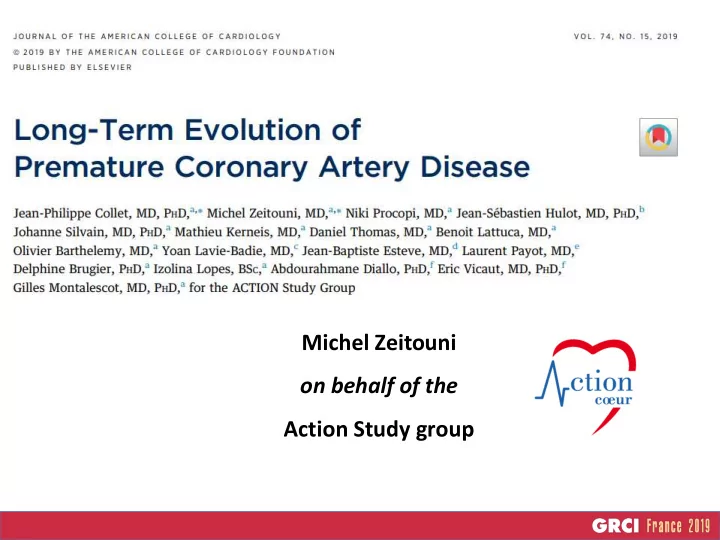

Michel Zeitouni on behalf of the Action Study group
DÉCLARATION DE LIENS D'INTÉRÊT AVEC LA PRÉSENTATION Speaker's name : Michel ZEITOUNI, Paris ☑ Je déclare les liens d'intérêt potentiel suivants : Bourse de Recherche : FFC, Institut Servier Honoraires : BMS / pfizer
Premature coronary artery ry dis isease - Increasing rate of MI among young patients - Spectacular increase among young women Arora Sameer et al. Twenty Year Trends and Sex Differences in Young Adults Hospitalized with Acute Myocardial Infarction: The ARIC Community Surveillance Study. Circulation [Internet] [cited 2018 Dec 10]
Premature coronary artery ry dis isease - Rare retrospective registries - Historically under-represented in clinical trials - Prognosis sought to be good at short-term but unknown at long-term TIMI-TRITON COMPASS - PROSPECT DAPT PEGASUS PLATO 38 CAD Population ACS/PCI CAD/PCI Post-MI ACS/PCI ACS/PCI High-risk CAD Mean age 58 62 65 62 61 68 (years)
Scientific Ju Justification Objective
AFIJI prospective registry Appraisal of risk factors in young ischemic patients Justifying aggressive intervention Consecutive patients since January 1996 from eight centers Patients 18 – 45 years-old Myocardial infarction or stable angina At least one coronary lesion > 70 % Oral and written consent Prospective follow-up until July 31st, 2017 Inclusion one Month after MI for exhaustive work-up (biobank, imaging) Yearly : data collection by consultation and phone
Endpoints The primary composite endpoint was ischemic recurrences defined by : all-cause death myocardial infarction Refractory angina requiring PCI or CABG Ischemic stroke Statistical analysis Kaplan Meier analysis survival without events according to lesion site Cox logistic regression with time-dependent co-variates
Scientif ific Ju Justification Objective Methods Results
Baseline characteristics N= 880 patients between 1996 et 2017 Median follow-up = 9.6 years Complete vital and cardiovascular status except for 5 patients Angiographic characteristics (n=880) Baseline characteristics n =880 One vessel 529 (60.1) Age - year (mean) 40∙1 ± 5∙ 7 179 (20.3) Two vessel Age < 35 % 160 (18∙1) 172 (19.5) Three vessel Female gender 117 (13∙3) Spontaneous coronary artery Myocardial infarction 693 (78∙8) 10 (1.1) dissection Stable angina 187 (21∙2) Effort-related thrombosis 11(1.3) Familial history of CAD 359 (40∙8) Revascularization 803 (91∙2) Active cigarette smoking 680 (77∙3%) Drug eluting stent 478 (54.4) Dyslipidaemia 443 (50∙3) Bare metal stent 304 (34.7) LDL-Cholesterol (g/L) 1∙69 ± 1∙30 Thrombus aspiration only 11 (1.3) Arterial hypertension 178 (20∙2) 57 (6.5) Coronary artery bypass graft Diabetes 94 (10∙7) Medical treatment 30 (3.4) Chronic inflammatory disease 87 (9∙9)
Clinical outcomes 1 st recurrence Time 2nd recurrence Recurrences ≥ 3 Total Events (n=264) (year, median) (n=81) (n=54) Primary endpoint 264 (29∙9) 4∙2 399 All-cause Death 39 (4∙4) 8∙4 11 (1∙3) 5 (0∙6) 55 (6∙3) Myocardial Infarction 131 (14∙9) 3∙7 40 (4∙5) 38 (4∙3) 209 (23∙8) STEMI 47 (5∙3) 4∙1 10 (1∙1) 12 (1∙4) 69 (7∙8) NSTEMI 84 (9∙5) 3∙5 30 (3∙4) 26 (3∙0) 140 (15∙9) Refractory Ischemia requiring 88 (10∙0) 5∙1 28 (3∙2) 11 (1∙3) 127 (14∙4) revascularization PCI 66 (7∙5) 6∙3 18 (2∙0) 2 (0∙2) 85 (9∙7) CABG 22(2∙5) 2∙8 10 (1∙1) 9 (1∙0) 41 (4∙7) Ischemic Stroke 6(0∙7) 5∙4 2 (0∙2) 0 (0) 8 (0∙9) Ischemic recurrences occurred in 1/3 of the patients within a median time of 4 years (4.2 per 100 patient-years)
Recurrences according to disease progression Ischemic recurrences were mainly related to new lesions 15.4 % vs 7.5 %, p<0.001, HR = 1.45
Evolution of risk factors : diabetes
Evolution of risk factors : Active smoking
Risk Factors of poor prognosis First ischemic recurrence
Risk Factors of poor prognosis First ischemic recurrence
Scie ientific Justification Objective Methods Results Conclusion & Dis iscussion
Conclusion A STEMI before 45 is always shocking Short-term prognosis is good. Coronaries are back to normal after PCI! Premature CAD is an aggressive chronic affection starting 20 years in advance Disconnect between what we see and long-term evolution Most of the recurrent events occured before comorbidities Smoking is the killer as well as chronic inflammation
Conclusion AFIJI PROSPECT DAPT STUDY PEGASUS TIMI 54 COMPASS-CAD CAD<45 ACS/PCI CAD/PCI Post-MI High-risk CAD Mean age 40 58 62 65 68 Active smokers 77% 48% 21% 17% 20% Diabetes 11% 17% 31% 32% 37% Multi-vessel disease 39% 79% NA 59% 63% Inflammatory disease 10% NA NA NA NA Events rate per 100 2.2 1.48 1.56 1.79 1.39 patient-years*
Discussion & Perspectives Limitations Different follow-up durations, different therapeutic eras Perspectives Ethnic and genetic analysis (DNA-tech) Hypercholesterolemia analysis Socio-professional status (ESC 2018) Vascular age with Cardiac MRI (FARMACOPE study) Collaboration with Duke Clinical Research Center Impact of inflammation and collaboration with CANTOS investigators
Merci de votre attention
Recommend
More recommend